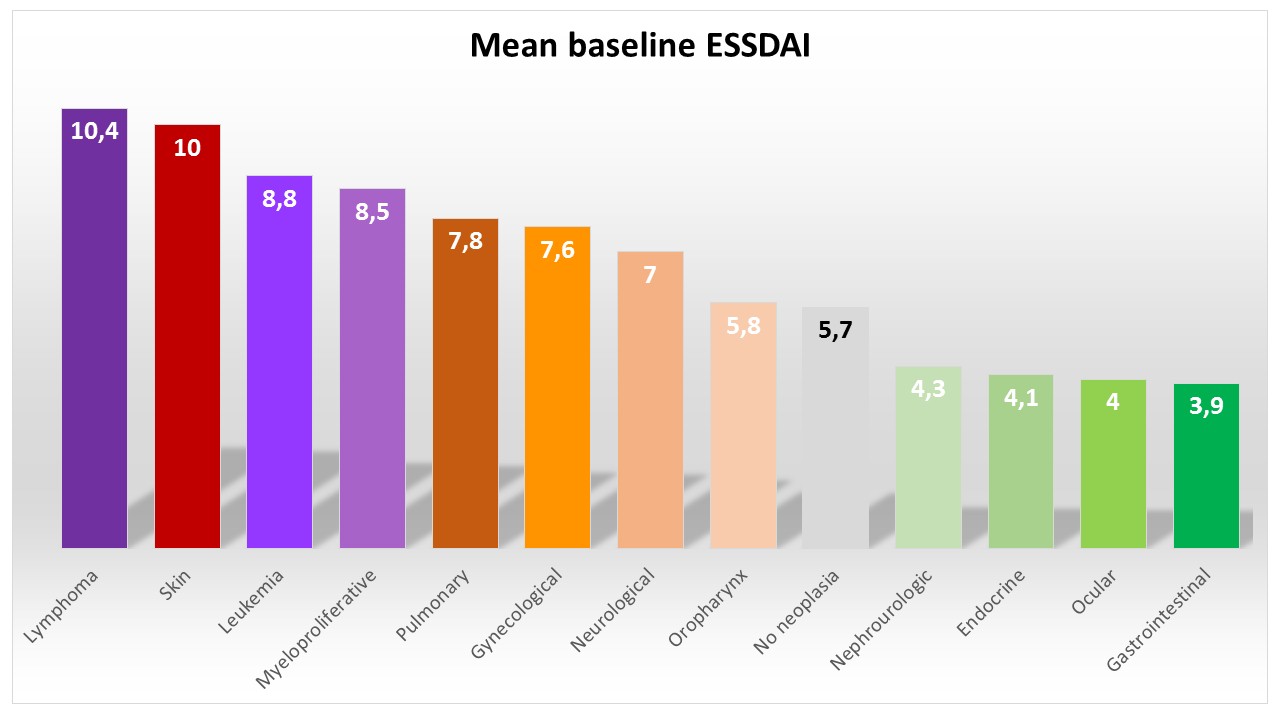Session Information
Session Type: ACR Poster Session C
Session Time: 9:00AM-11:00AM
Background/Purpose: To score systemic activity at diagnosis of primary Sjogren syndrome (pSS) using the European systemic activity indexes ESSDAI, clinESSDAI and DAS in order to evaluate their influence in the development of cancer in a large cohort of patients.
Methods: The GEAS-SS multicenter registry was formed in 2005 with the aim of collecting a large series of Spanish patients with primary SS, and included 21 Spanish reference centers with substantial experience in the management of SS patients. By January 2016, the database included 1301 consecutive patients fulfilling the 2002 classification criteria for primary SS. ESSDAI, clinESSDAI and disease activity states (DAS) scores were retrospectively calculated at diagnosis. Neoplasias diagnosed before the pSS diagnosis were excluded.
Results: The cohort included 1202 (92%) women with a mean age at diagnosis of pSS of 52 years. According to the 2002 AE criteria, 1280 patients (98%) had dry mouth, 1235 (95%) dry eyes, 1013/1156 (88%) abnormal ocular tests, 498/630 (79%) positive minor salivary gland biopsy, 835/993 (86%) abnormal oral diagnostic tests, 982/1295 (76%) positive anti-Ro/SSA antibodies and 627/1295 (48%) positive anti-La/SSB antibodies. Other immunological markers included ANA in 1125/1296 (87%) patients, RF in 584/1246 (47%), low C3 levels in 144/1234 (12%), low C4 levels in 163/1219 (13%), cryoglobulins in 70/930 (7.5%) and monoclonal band in 115/1019 (11%). After a mean follow-up of 118 months, 70 (5.4%) patients developed solid cancer and 61 (4.7%) hematological neoplasia; according to the ICD codes, the most frequent neoplasia were lymphoma (n=50), gynecological (n=20), gastrointestinal (n=16) and endocrine (n=8) neoplasias. Systemic activity at diagnosis was significantly higher in patients who developed hematological neoplasia in comparison with those who developed solid neoplasia or those without neoplasia, both for the mean ESSDAI (10.4 vs 5.9 vs 5.7, p<0.001) and clinESSDAI (10.3 vs 5.8 vs 5.7, p<0.001) scores. In addition, high systemic activity (high-DAS) was found in a higher frequency in patients who developed hematological in comparison with those who developed solid neoplasia or those without neoplasia (40% vs 7.7% vs 10.8%, p<0.001). The highest baseline ESSDAI scores were found in patients who developed lymphoma (10.4), skin cancer (10), leukemia (8.8), myeloproliferative cancer (8.5), pulmonary (7.8) and gynecological (7.6) neoplasia (Figure 1).
Conclusion: Systemic activity at diagnosis measured using ESSDAI, clinESSDAI and DAS scores is closely related to the development of lymphoma, but not with solid cancer, in patients with pSS. Etiopathogenic factors such as B-cell hyperactivity and cryoglobulinemic-driven immunological responses may play a dual effect, enhancing the risk of development of both systemic involvement and hematological neoplasia.
To cite this abstract in AMA style:
Retamozo S, Kostov B, Fraile G, Caravia-Durán D, Maure B, Rascón FJ, Zamora M, Casanovas A, Lopez-Dupla M, Ripoll M, Pinilla B, Fonseca E, Akasbi M, De la Red G, Duarte-Millán MA, Fanlo Mateo P, Guisado P, Pérez-Alvarez R, Rodríguez-Rodríguez S, Morcillo C, Jiménez-Heredia I, Gato A, Gratacós J, Sánchez-Berná I, Ramos-Casals M, Brito-Zerón P. Essdai, Clinessdai and DAS Scoring at Diagnosis of Primary Sjogren Syndrome: Association with the Development of Hematologic and Solid Neoplasias in 1301 Patients [abstract]. Arthritis Rheumatol. 2016; 68 (suppl 10). https://acrabstracts.org/abstract/essdai-clinessdai-and-das-scoring-at-diagnosis-of-primary-sjogren-syndrome-association-with-the-development-of-hematologic-and-solid-neoplasias-in-1301-patients/. Accessed .« Back to 2016 ACR/ARHP Annual Meeting
ACR Meeting Abstracts - https://acrabstracts.org/abstract/essdai-clinessdai-and-das-scoring-at-diagnosis-of-primary-sjogren-syndrome-association-with-the-development-of-hematologic-and-solid-neoplasias-in-1301-patients/

